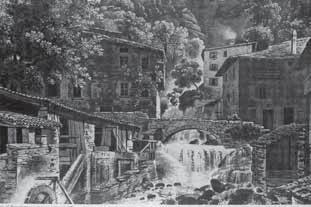Summary 16 The Pozzo Canseria: a twenty years old sump The Pozzo Canseria, discovered in 1991 by Ibleo Caving Club, opens on Ibleo Plateau, in Noto territory (Siracusa - Italy). The exploration of this cave was limited to a narrow entrance and a series of pits (P25, P17 and P3) ending in a sump. In 2009 the right intuition: the Speleo Club Ibleo and Gruppo Speleologico Siracusano decided to empty the siphon with an electric pump. This opened the way to the biggest discovery in Sicily since the last 20 years: 1.6 km of explored tunnels, four other sumps to explore and a complex river cave.
40 Lovettecannas a new exploration season After 4 years from the latest explorations, new researches have been undertaken in the Lovettecannas cave (Baunei region, Nuoro, Sardinia). A new and interesting branch has been explored, with the discovery of a big chamber, named by the explorers “Salone Marco Mattu”. Furthermore some new hydrological researches have been carried out that have established that the waters of Lovettecannas also flow into the Codula Ilune system. 50 Speleology and glaciology in the Perito Moreno Glaciar and Ameghino Glaciar
26 The Bussento underground river The Bussento underground river is one of the most important and famous karst systems of Cilento in the region of Campania; this system is composed of six caves: the Bussento Sinkhole (566 m long –26 m deep), Bussento cave spring (830 m long, + 54 m deep), Cozzetta-Orsivacca complex (1,5 km long, –148 m deep), Carvaro Sinkhole (122 m long, –153 m deep) and Pozzo le Fontane (65 m long, –140 m deep). The whole karst area was explored since the 50sbut by 2005 the Speleological Group CAI of Naples has carried out a new cave survey, discovering some new branches in Cozzetta-Orsivacca complex, while in the Bussento cave spring the first sump has been explored until the depth of –47 m without reaching the bottom. 35 Lombardia karstic area observatory The Speleological Federation of Lombardia (FSLo) and the Region of Lombardia have realized a broad and structured project to know better and to safeguard the regional karst areas. In this project all caving clubs of Lombardia are involved; the hope is that this project will be extended also to a national scale.
In the last decades the glaciers of Southern Patagonian Andes have experienced a very fast and intensive retreat, due to the current strong ablation considered as an effect of “global warming”. The Perito Moreno Glacier is an exception to this “rule”. In fact, the most famous characteristic of this glacier is the cyclical advancement of the front which can reach the rocky spur of the Peninsula Magellanes, closing the water passage between the two braces of Lake Argentino. The causes of this peculiar behavior are not completely clear. In its current state, the glacier has three areas having morphological and hydrological conditions suitable for the formation of glacier caves. All three contain well developed superficial drainage networks which feed bédière up to over a kilometer long. Conversely, the Glaciar Ameghino, which is located just a few kms to north, was affected by an impressive retreat in the last decades. Actually, both Perito Moreno and Ameghino host several pseudo karst forms due to surface and internal melting and we suspect that these phenomena could have a role in the different dynamics of the two glaciers.
59 Boreas, the blow of Zeus Since the 80’s the Sparviere Speleological Group, in co-operation with different Greek Caving Clubs, explored some karst areas of Lakonia in the South-Estern part of Peloponneso. The most important of which is the big and beautiful Hole of Bora (988 m long and –140 m deep). Many others caves were found in the districts of Niata, Molai and Zarakas, among them: Spileo sto Vieles (228 m long, and 40 m depth), Spileo sto Vrì (100 m long, and –40 m deep), Spileo Varatro Hilas (200 m long, and –47 m deep). 66 Where starts a cave? This brief note deals with the problem of the correct definition of the entrance of a cave and its positioning by a coordinate system. Given a few meters wide cave access, the entrance coordinate reference point should refer to its perimeter geometric barycentre.
96 Speleologia65/2011














